
Thursday, 20 November 2008
Planting Bulbs in the Four Season Garden at The New York Botanical Garden
When Paul and I were here at NYBG on Tuesday (for the holiday train show press preview) we strolled around the grounds to look at some of the Henry Moore sculptures on display through January 11, 2009. In the rock garden we came across two volunteers planting bulbs. Bags of bulbs, like the little species tulips awaiting their descent underground,

and dwarf iris, just needing a backfill of soil and a gravel mulch.
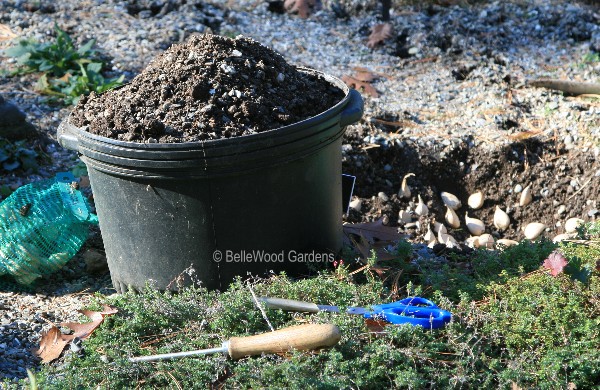
Other bags of a variety of little bulbs were sited here and there. "I hope," said Wilhelmina,
"that we get done planting them before the ground freezes." Fingers crossed,
I wish the same for my not-yet-planted bulbs back home.
These are not the only bulbs at The New York Botanical Garden ducking underground to wait for spring when they can entertain garden visitors. There's this long double border adjacent to the Enid A. Haupt Conservatory. The Seasonal Walk, as it's named, is a path between two deep borders. One is 184 feet long, and the other, 86 feet in length. Each fall they're planted with about a zillion tulips. Then, after the tulips bloom, the bulbs are dug and replaced with a display of annuals and tender tropicals. In turn, they're cleared away in the fall, making way for planting tulips. You get the idea. This year, however, there's something different.
The Enid Haupt Conservatory has a wing dedicated to unique, often seasonal displays such as the holiday train show. The spring 2009 exhibition: The Glory of Dutch Bulbs: A Legacy of 400 Years, will feature Dutch bulbs and be sort of the kick-off for a series of New York events commemorating the 400th anniversary of Henry Hudsonís voyage to New Amsterdam / New York. And to complement the Conservatory exhibition, the Seasonal Walk will be a once-planted but year-long, four seasons of interest border, featuring many spring- and summer-blooming bulbs anchored by perennials and ornamental grasses.
Internationally renowned Dutch garden designers Piet Oudolf of Hummelo, the Netherlands, and Jacqueline van der Kloet of Weesp, the Netherlands, collaborated in the custom design for these borders. Piet Oudolf, preeminent among the New Wave landscape designers for his use of plants with extended interest, selected and placed the perennials. Jacqueline van der Kloet, who is wonderfully changing the way bulbs are used in gardens, designed that aspect. Together, they're creating a display that should be remarkably different from what's previously been done with this space.

I paused on my way to the Conservatory last Tuesday. The perennials have been planted,
their locations and patterns marked out with colored flagging tape. There's a feeling of expectancy for me.
On Thursday, there's to be a ceremonial planting of bulbs. Her royal highness, Princess Margriet of the Netherlands
and her husband, Prof. Pieter van Vollenhoven, will be here, as will Piet Oudolf, Jacqueline van der Kloet, and
Frans Roozen, technical director of the International Flower Bulb Centre of Hillegom, the Netherlands.
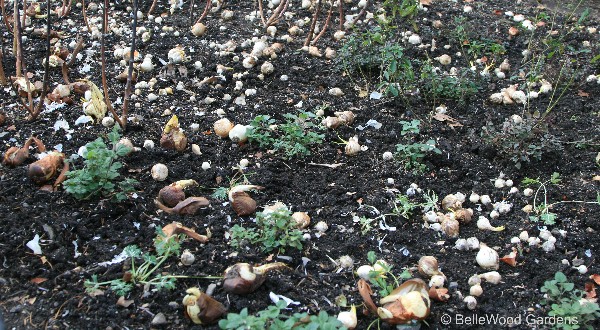
What a jumble. There's colchicum and tulips, some daffodils and a few alliums,
little scilla and some crocus and more, all intermingled and uneven. If you're used to
neat and tidy groupings of bulbs - this kind here and a gap before the next,
well then, this looks very confused. I like bulbs and perennials intermingled, but
bulbs intermingled with bulbs? Good thing I heard Jacqueline's lecture
at the Perennial Plant Association annual meeting in Philadelphia last summer
and will have a chance to interview her in Thursday, after the ceremonial bulb planting.
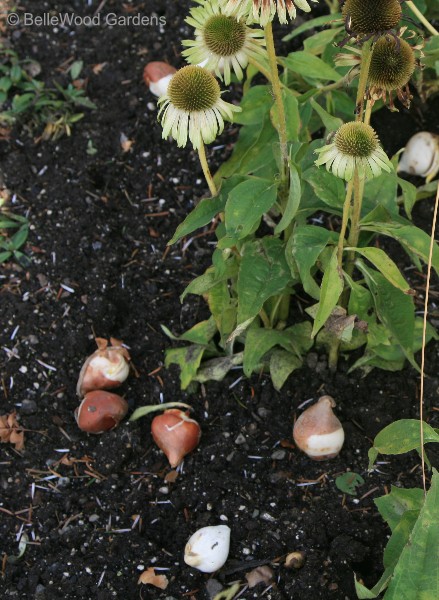
A handful of tulips tossed out and come to rest adjacent to an echinacea.
.
Tulips are familiar to gardeners and non-gardeners alike. The ones we know best
are the big May flowering Darwin and Triumph hybrids that come in a rainbow array.
Back 400 years when Henry Hudson was making sail for the New World, tulips looked
rather different. Red and yellow Tulipa 'Duc van Tol' dates back to 1595. It is
the oldest tulip cultivar in the historic collections of the Hortus Bulborum.

It was the Hortus Bulborum that provided 150 'Duc van Tol' red and yellow tulips for planting
in the Four Season Border. (And if you are wondering why I'm emphasizing the colors,
it is because there are also Duc van Tol Rose, Aurora, and Violet. The only source for these heirloom bulbs
I'm aware of on this side of the ocean is Old House Gardens. Too late to order any this year.
If you want this piece of history for your own garden order early next fall, supplies are always limited.

.

Here's Frans Roozen, wearing his wooden kloompen, explaining to her royal highness
about the kneeler pads and Dutch bulb planting tools as her husband looks on.
There was, by the way, an engraved crown on each of the royal bulb planting trowels.
(If you want an Old Dutch trowel, you can find them at Sneeboer Tools)

Frans, on the left, and Jacqueline, on the right, demonstrate proper bulb planting technique.

Some may have had more experience but everyone gets to work.

Jacqueline and Piet finish first, planting the bulbs in front of them in jig time.
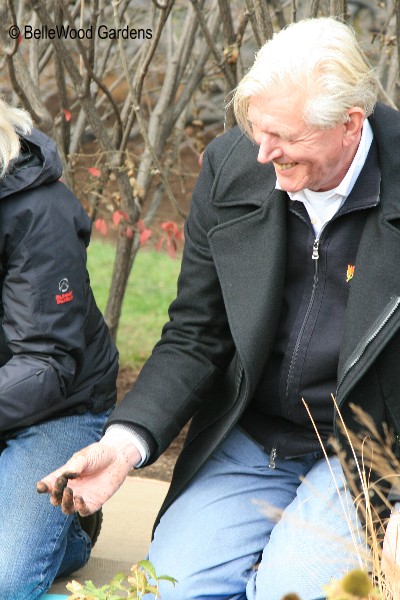
Piet has dirt on his hands. Not the first, and no doubt not the last time either.
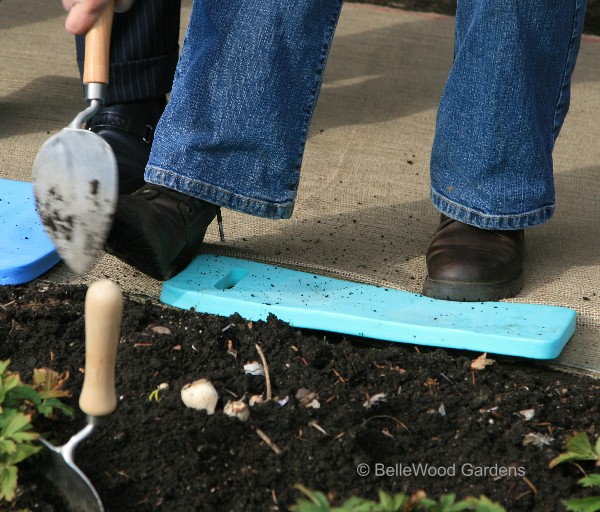
Not good to leave wet soil on tools, else they rust. Piet uses his shoe to casually scrape away the dirt.
.
While offering neither rain nor snow the weather is quite chilly with an occasional sharp breeze.
Planting over, we head off into the garden's nearby restaurant. I have the 12:15 to 12:30 p.m. interview slot.
Jacqueline and I sit at the table reserved for us. I flip open my notebook and like Kipling's insatiable
elephant child, start asking questions. Here's what she had to say about bulbs and how she uses them.
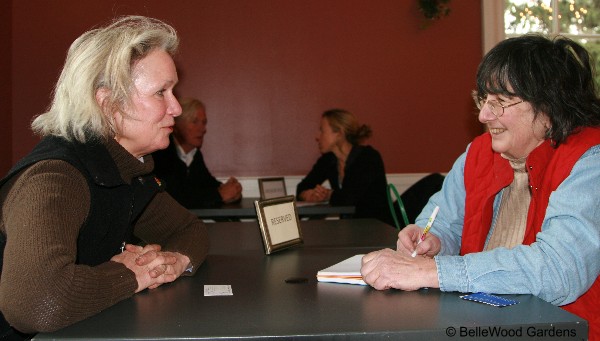
Photograph Credit Mary Masilamani 2008
Jacqueline began designing and planting her garden in 1985, first working with
perennials, shrubs, and trees. A hectare (2.5 acre) in size, rather large for the Netherlands,
she had a grand time experimenting and playing with plant combinations. The International Flower Bulb Centre
asked her to work with bulbs. Since she prefers a natural look, Jacqueline began to mix varieties of bulbs and
to scatter them with a gentle toss, for a more natural effect. She recommends planting approximately
7 or 8 perennials per m≤, interspersing 12 to 15 bulbs. Smaller bulbs are scattered overall, while
larger bulbs are planted more thickly. One combination she finds especially pleasing blends
green and white viridiflora tulip 'Spring Green' with Camassia and Muscari 'Saffir'.
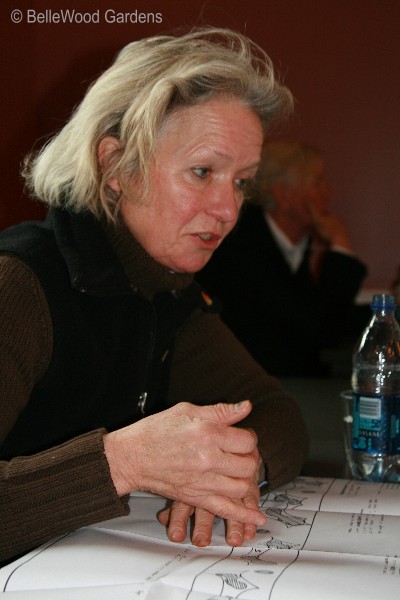
Photograph Credit Mary Masilamani 2008
Showing me the bulb planting plan Jacqueline explains that there are some round groupings
where the bulbs are planted more thickly. Then there are other dense plantings that she refers to as
"peanuts" each incorporated into a larger but more diffuse planting of the same mixture of bulbs
that she designated as "bats." The end result is a pleasing, softer edge for the group of bulbs,
with a stronger nucleus. This is in contrast to the traditional style, sharp edged and rather rigid in feel.
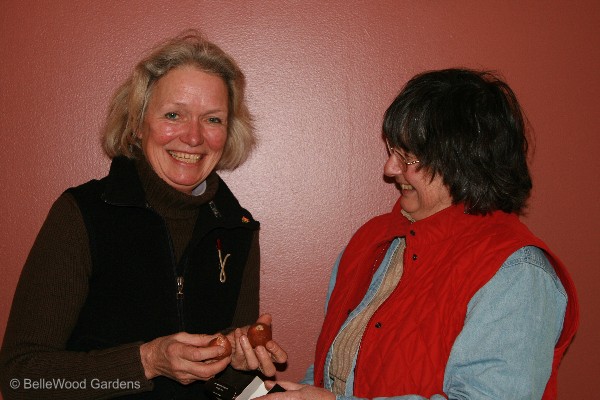
Photograph Credit Mary Masilamani 2008
"The International Flower Bulb Centre has gifted the participants in today's events with a box of
'Henry Hudson' tulips, a new red and yellow cultivar. Jacqueline has some of the plump bulbs
in her hand. Now, if my ground is not frozen solid, I'll get them planted this weekend. I even have a Dutch
style bulb planting trowel. Not stainless steel, no engraved crown, yet it has helped me plant many, many bulbs
and will, again, for planting these. But I need to find some companion bulbs, to make a "Van der Kloet" grouping.